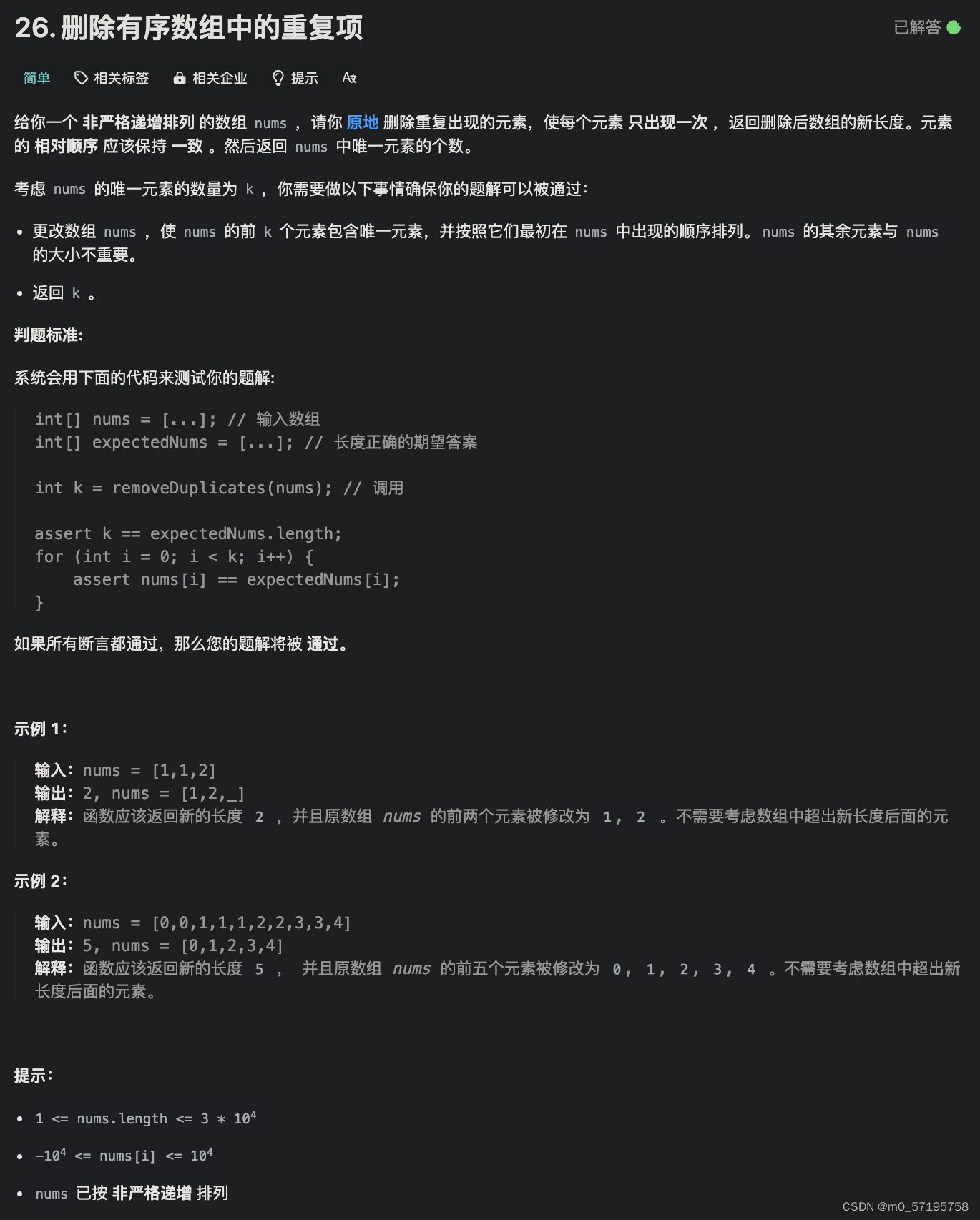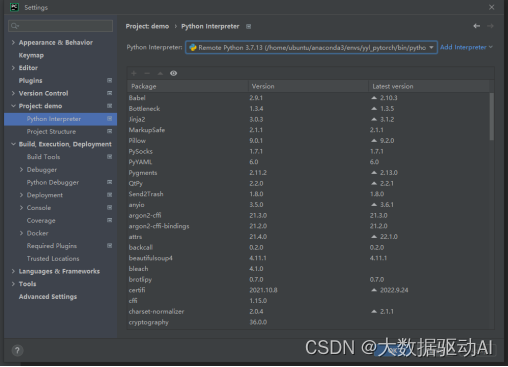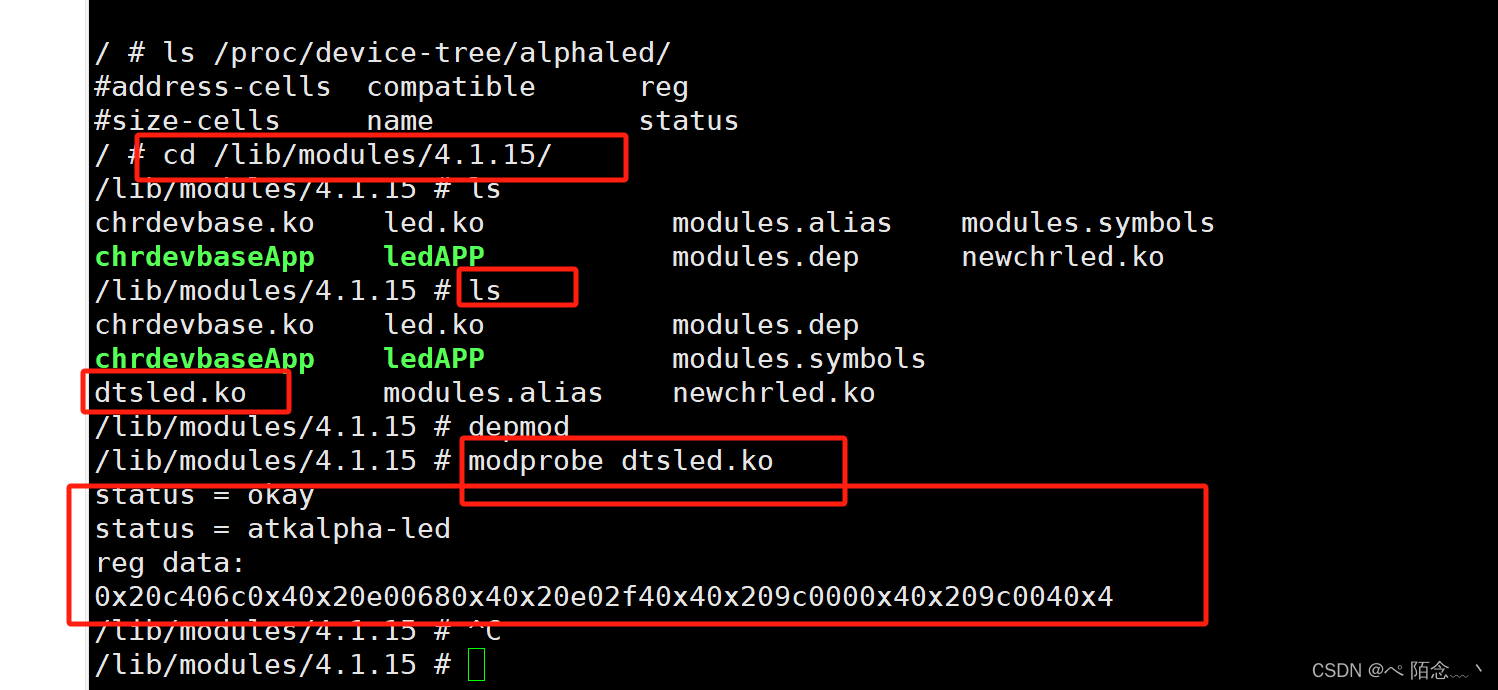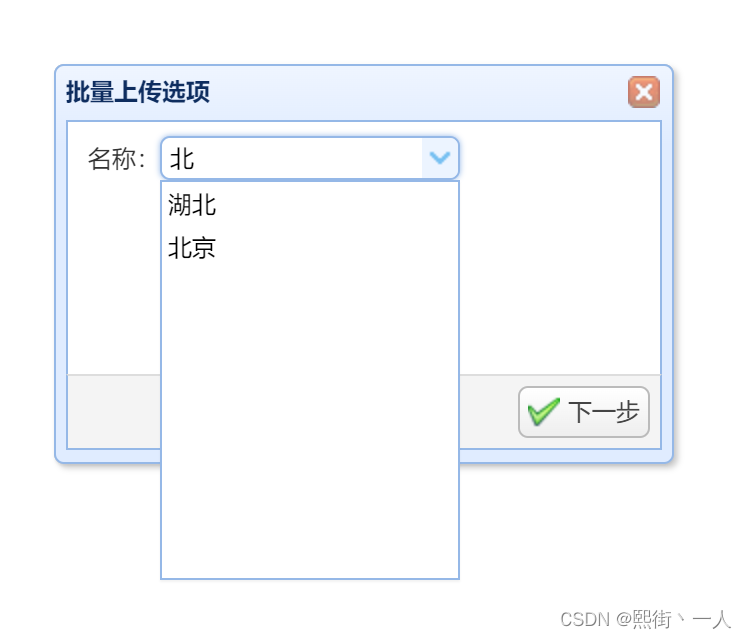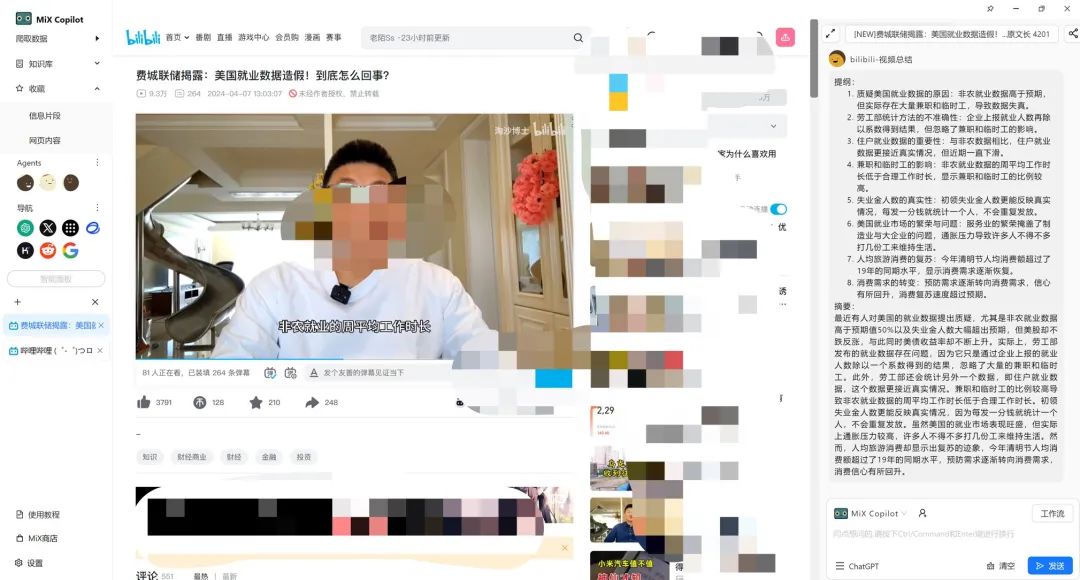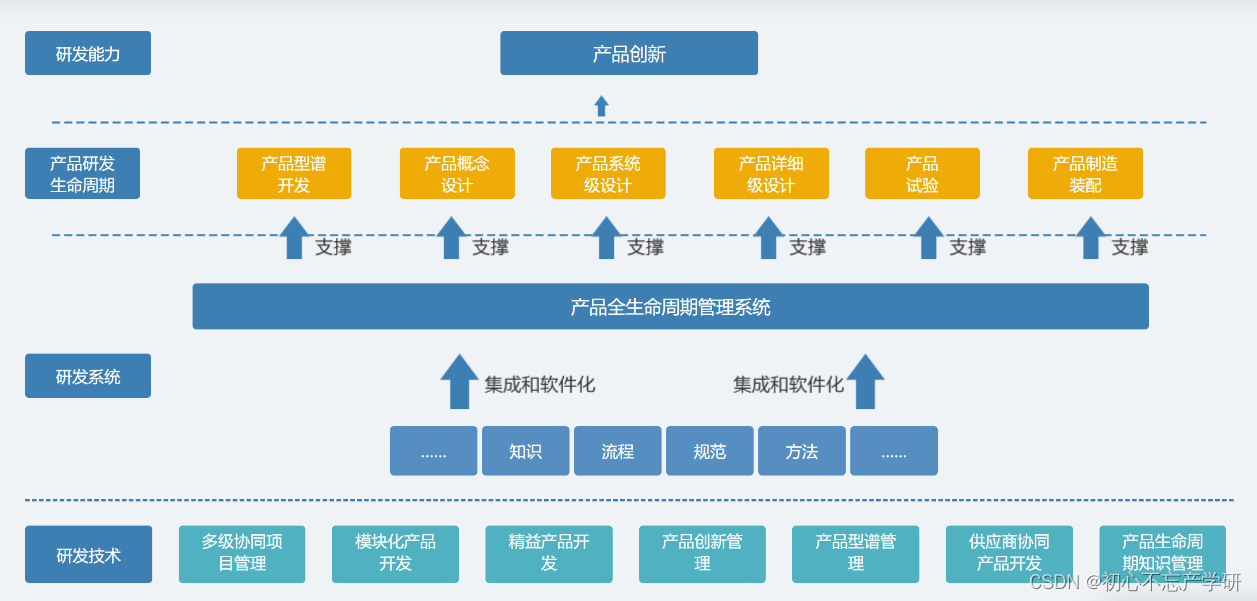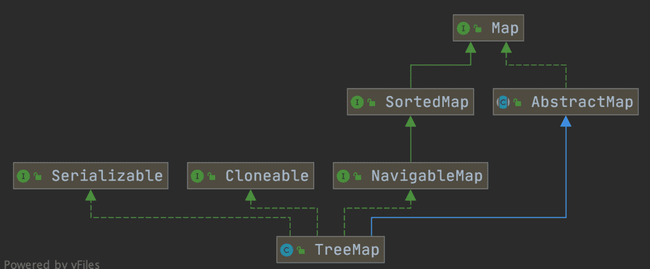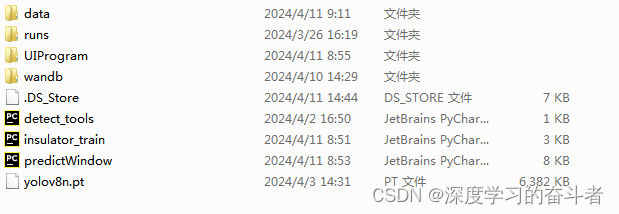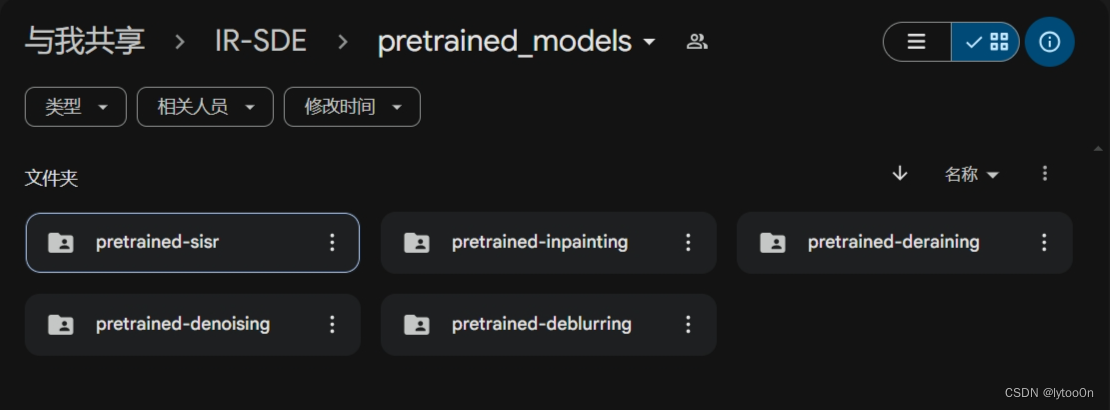目录
- 安全框架?
- 安全框架都有哪些?
- 什么是RBAC?
- Shiro
- Shiro核心组件
- Shiro的运行机制
- SpringBoot整合Shiro
- 整合思路
- 1.引入依赖
- 2.项目结构及配置
- 3.创建前端页面
- index.jsp
- login.jsp
- 4.自定义Realm
- 5.自定义配置类
- 6.启动测试
- 认证和退出
- 1.在index.jsp添加a标签
- 2.Controller
- 3.修改自定义Realm
- 4.修改ShiroConfig配置
- 5.测试
- MD5、Salt的认证实现
- 1.建表
- 2.依赖
- 3.工具类
- 4.实体类、Mapper、Service、Controller
- 5.注册页面
- 6.修改自定义Realm
- 7.修改Config
- 8.测试
- 授权
- 1.建表(五个核心表)
- 2.实体类、mapper、service、controller
- 实体类
- mapper
- service
- 3.CustomerRealm
- 4.页面(index.jsp)
- 5.数据参考
- 6.测试
- Shiro结合缓存
- 整合redis
- 1.依赖
- 2.配置
- 3.Redis相关类
- 4.自定义salt实现 实现序列化接口
- 5.修改自定义realm中使用的salt
- 6.ShiroConfig创建自定义realm
- 7.测试
- shrio实现验证功能
- 1.验证码工具类
- 2.登录页面
- 3.Controller
- 4.验证码放行
- 5.测试
- JSP中的Shiro标签解释
- Shiro与thymeleaf
- 1.依赖
- 2.常见权限控制标签使用
- 3.加入shiro的方言配置
安全框架?
-
给项目添加认证与授权功能的框架, 就叫安全框架
-
认证: 验证用户身份的合法性(验证用户名和密码是否正确)
-
授权: 授权用户访问资源的权限
安全框架都有哪些?
- Spring Security
- Shiro
- sa-token
什么是RBAC?
RBAC是Role-Based Access Control(基于角色的访问控制)的缩写。它是一种广泛应用于安全管理中的访问控制模型。RBAC模型通过授予用户不同的角色,并将角色与权限进行关联,来管理对资源的访问。
RBAC模型中的关键概念包括以下几个部分:
- 角色(Role):角色是一组具有相似职责和权限的用户集合。例如,管理员、编辑、访客等都可以是角色。
- 权限(Permission):权限是指执行特定操作或访问特定资源的能力。例如,读取、写入、删除等操作可以被视为不同的权限。
- 用户(User):用户是系统中的个体,可以被授予一个或多个角色。
- 资源(Resource):资源是系统中受到访问控制的对象。可以是文件、数据库记录、API接口等。
Shiro
官网:https://shiro.apache.org/

是一款主流的Java安全框架,不依赖任何容器,可以运行在Java SE和Java EE项目中,它的主要作用是对访问系统的用户进行身份认证、授权、会话管理、加密等操作。
Shiro 就是用来解决安全管理的系统化框架。Shiro是基于session的身份认证和访问控制框架。
Shiro核心组件
用户、角色、权限。给角色赋予权限、给用户赋予角色
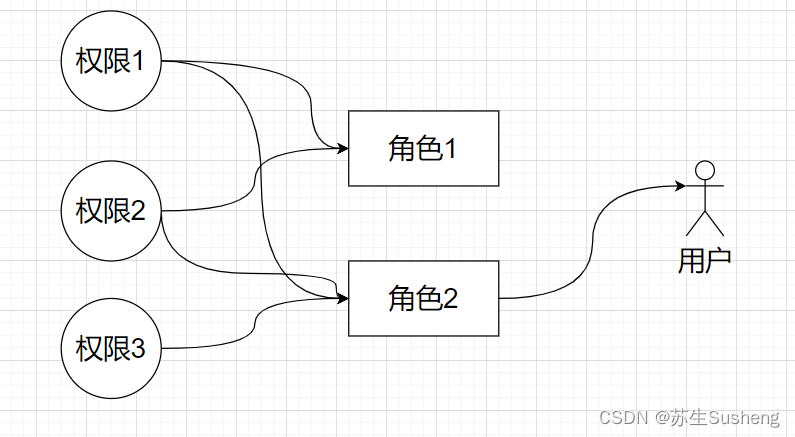
- UsernamePasswordToken,Shiro用来封装用户登录信息,使用用户的登录信息来创建令牌Token。
- SecurityManager,Shiro的核心部分,负责安全认证和授权。
- Subject,Shiro的一个抽象概念,包含了用户信息。
- Realm,开发者自定义的模块,根据项目的需求,验证和授权的逻辑全部写在Reaim中。
- AuthenticationInfo,用户的角色信息集合,认证时使用。
- AuthorzationInfo,角色的权限信息集合,授权时使用。
- DefaultWebSecurityManager,安全管理器,开发者自定义的Realm需要注入到DefaultWebSecurityManager进行管理才能生效
- ShiroFilterFactoryBean,过滤器工厂,Shiro的基本运行机制是开发者定制规则,Shiro去运行,具体的执行操作就是由ShiroFilterFactoryBean
Shiro的运行机制
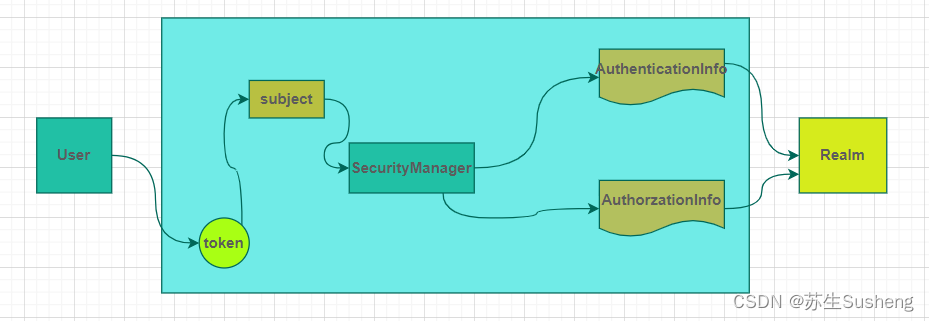
SpringBoot整合Shiro
整合思路
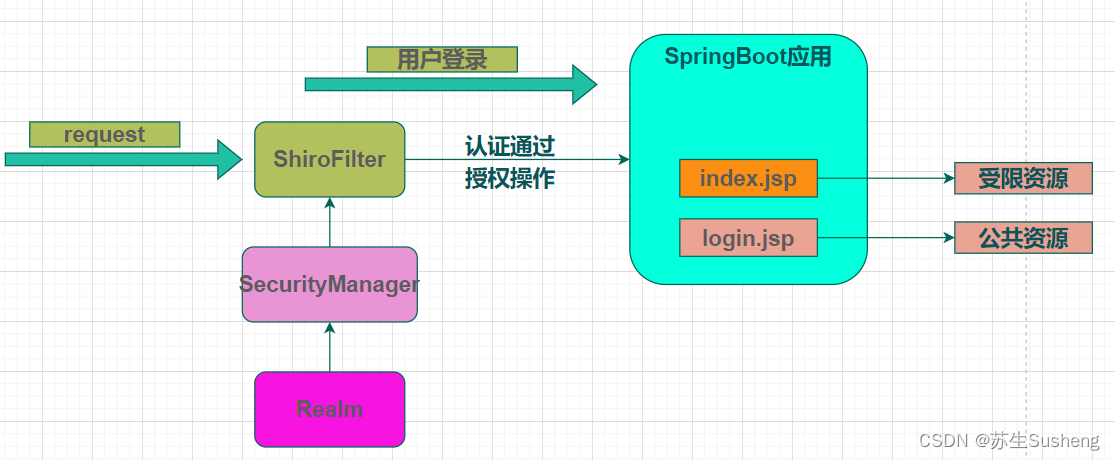
1.引入依赖
这里使用jsp来做前端页面,因此需要引入jsp依赖
<dependencies>
<dependency>
<groupId>org.springframework.boot</groupId>
<artifactId>spring-boot-starter-web</artifactId>
</dependency>
<dependency>
<groupId>org.springframework.boot</groupId>
<artifactId>spring-boot-devtools</artifactId>
<scope>runtime</scope>
<optional>true</optional>
</dependency>
<dependency>
<groupId>org.projectlombok</groupId>
<artifactId>lombok</artifactId>
<optional>true</optional>
</dependency>
<dependency>
<groupId>org.springframework.boot</groupId>
<artifactId>spring-boot-starter-test</artifactId>
<scope>test</scope>
</dependency>
<!--引入 Spring Boot 内嵌的 Tomcat 对 JSP 的解析包,不加解析不了 jsp 页面-->
<!--如果只是使用 JSP 页面,可以只添加该依赖-->
<dependency>
<groupId>org.apache.tomcat.embed</groupId>
<artifactId>tomcat-embed-jasper</artifactId>
</dependency>
<!--如果要使用 servlet 必须添加该以下两个依赖-->
<!-- servlet 依赖的 jar 包-->
<dependency>
<groupId>javax.servlet</groupId>
<artifactId>javax.servlet-api</artifactId>
</dependency>
<!-- jsp 依赖 jar 包-->
<dependency>
<groupId>javax.servlet.jsp</groupId>
<artifactId>javax.servlet.jsp-api</artifactId>
<version>2.3.1</version>
</dependency>
<!--如果使用 JSTL 必须添加该依赖-->
<!--jstl 标签依赖的 jar 包 start-->
<dependency>
<groupId>javax.servlet</groupId>
<artifactId>jstl</artifactId>
</dependency>
<dependency>
<groupId>org.apache.shiro</groupId>
<artifactId>shiro-spring-boot-starter</artifactId>
<version>1.5.3</version>
</dependency>
</dependencies>
<build>
<plugins>
<plugin>
<groupId>org.springframework.boot</groupId>
<artifactId>spring-boot-maven-plugin</artifactId>
<configuration>
<excludes>
<exclude>
<groupId>org.projectlombok</groupId>
<artifactId>lombok</artifactId>
</exclude>
</excludes>
</configuration>
</plugin>
</plugins>
<!-- SpringBoot 要求 jsp 文件必须编译到指定的META-INF/resources 目录下才能访问,否则访问不到。其它官方已经建议使用模版技术 -->
<resources>
<resource>
<!--源文件位置-->
<directory>src/main/webapp</directory>
<!--指定编译到META-INF/resource,该目录不能随便写-->
<targetPath>META-INF/resources</targetPath>
<!--指定要把哪些文件编译进去,**表示 webapp 目录及子目录,*.*表示所有文件-->
<includes>
<include>**/*.*</include>
</includes>
</resource>
</resources>
</build>
2.项目结构及配置
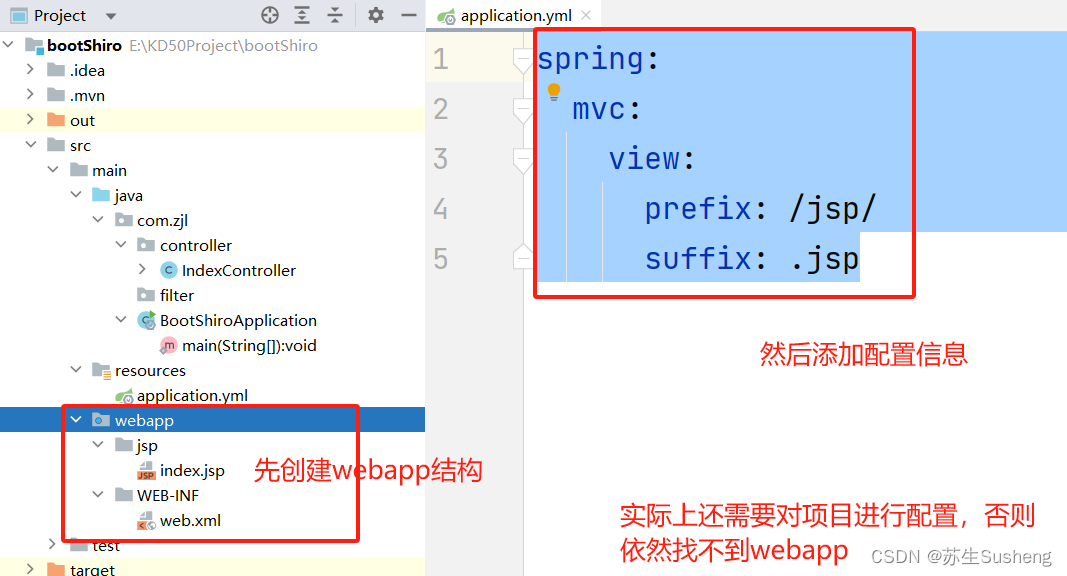
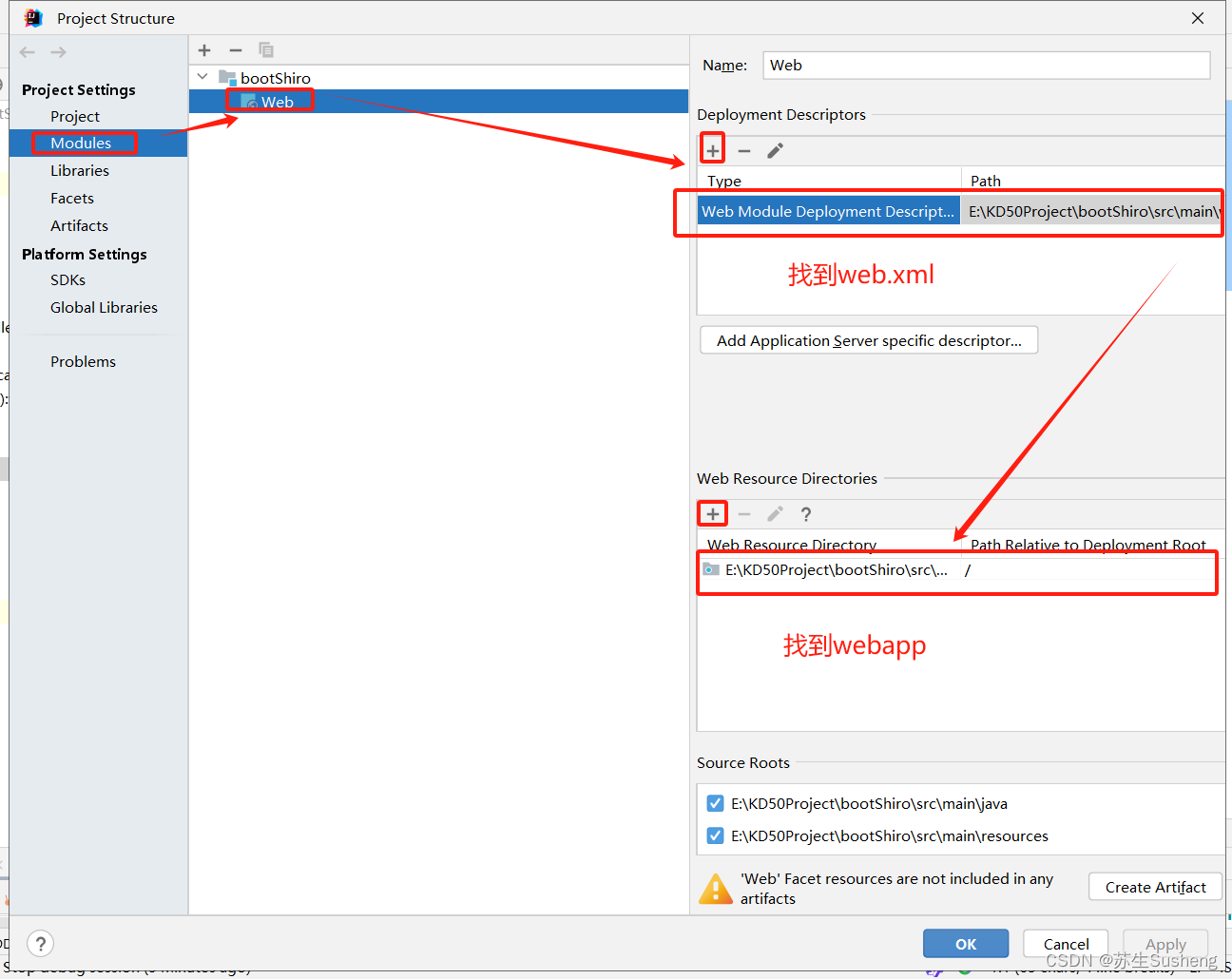
3.创建前端页面
在webapp文件夹中创建index.jsp和login.jsp
index.jsp
<%@page contentType="text/html;UTF-8" pageEncoding="UTF-8" isErrorPage="false" %>
<!doctype html>
<html lang="en">
<head>
<meta charset="UTF-8">
<meta name="viewport"
content="width=device-width, user-scalable=no, initial-scale=1.0, maximum-scale=1.0, minimum-scale=1.0">
<meta http-equiv="X-UA-Compatible" content="ie=edge">
<title>首页</title>
</head>
<body>
<%--受限资源--%>
<h1>系统主页</h1>
<ul>
<li><a href="#">用户管理</a></li>
<li><a href="#">商品管理</a></li>
<li><a href="#">订单管理</a></li>
<li><a href="#">物流管理</a></li>
</ul>
</body>
</html>
login.jsp
<%@page contentType="text/html;UTF-8" pageEncoding="UTF-8" isErrorPage="false" %>
<!doctype html>
<html lang="en">
<head>
<meta charset="UTF-8">
<meta name="viewport"
content="width=device-width, user-scalable=no, initial-scale=1.0, maximum-scale=1.0, minimum-scale=1.0">
<meta http-equiv="X-UA-Compatible" content="ie=edge">
<title>登录</title>
</head>
<body>
<h1>登录界面</h1>
<form action="${pageContext.request.contextPath}/login" method="post">
用户名:<input type="text" name="username" > <br/>
密码 : <input type="text" name="password"> <br>
<input type="submit" value="登录">
</form>
</body>
</html>
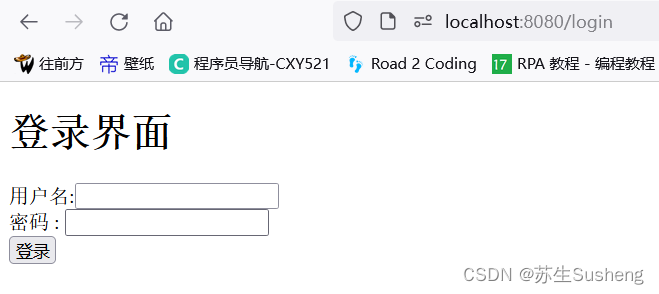

4.自定义Realm
package com.zjl.realm;
import org.apache.shiro.authc.AuthenticationException;
import org.apache.shiro.authc.AuthenticationInfo;
import org.apache.shiro.authc.AuthenticationToken;
import org.apache.shiro.authz.AuthorizationInfo;
import org.apache.shiro.realm.AuthorizingRealm;
import org.apache.shiro.subject.PrincipalCollection;
/**
* @author: zjl
* @datetime: 2024/4/11
* @desc:
*/
public class CustomerRealm extends AuthorizingRealm {
@Override
protected AuthorizationInfo doGetAuthorizationInfo(PrincipalCollection principalCollection) {
return null;
}
@Override
protected AuthenticationInfo doGetAuthenticationInfo(AuthenticationToken authenticationToken) throws AuthenticationException {
return null;
}
}
5.自定义配置类
package com.zjl.config;
import com.zjl.realm.CustomerRealm;
import org.apache.shiro.realm.Realm;
import org.apache.shiro.spring.web.ShiroFilterFactoryBean;
import org.apache.shiro.web.mgt.DefaultWebSecurityManager;
import org.springframework.context.annotation.Bean;
import org.springframework.context.annotation.Configuration;
import java.util.HashMap;
import java.util.Map;
/**
* @author: zjl
* @datetime: 2024/4/11
* @desc:
*/
@Configuration
public class ShiroConfig {
//ShiroFilter过滤所有请求
@Bean
public ShiroFilterFactoryBean getShiroFilterFactoryBean(DefaultWebSecurityManager securityManager) {
ShiroFilterFactoryBean shiroFilterFactoryBean = new ShiroFilterFactoryBean();
//给ShiroFilter配置安全管理器
shiroFilterFactoryBean.setSecurityManager(securityManager);
//配置系统受限资源
//配置系统公共资源
Map<String, String> map = new HashMap<String, String>();
map.put("/","anon");//表示这个资源需要认证和授权
map.put("/index","authc");//表示这个资源需要认证和授权
// 设置认证界面路径
shiroFilterFactoryBean.setLoginUrl("/login");
shiroFilterFactoryBean.setFilterChainDefinitionMap(map);
return shiroFilterFactoryBean;
}
//创建安全管理器
@Bean
public DefaultWebSecurityManager getDefaultWebSecurityManager(Realm realm) {
DefaultWebSecurityManager securityManager = new DefaultWebSecurityManager();
securityManager.setRealm(realm);
return securityManager;
}
//创建自定义Realm
@Bean
public Realm getRealm() {
CustomerRealm realm = new CustomerRealm();
return realm;
}
}
6.启动测试
访问:http://localhost:8080/index,会跳转到login
附Controller代码
package com.zjl.controller;
import org.springframework.stereotype.Controller;
import org.springframework.web.bind.annotation.RequestMapping;
/**
* @author: zjl
* @datetime: 2024/4/11
* @desc:
*/
@Controller
public class IndexController {
@RequestMapping("/")
public String login(){
return "login";
}
@RequestMapping("/index")
public String index(){
return "index";
}
}
认证和退出
1.在index.jsp添加a标签
<a href="${pageContext.request.contextPath}/logout">退出登录</a>
2.Controller
package com.zjl.controller;
import lombok.extern.slf4j.Slf4j;
import org.apache.shiro.SecurityUtils;
import org.apache.shiro.authc.IncorrectCredentialsException;
import org.apache.shiro.authc.UnknownAccountException;
import org.apache.shiro.authc.UsernamePasswordToken;
import org.apache.shiro.subject.Subject;
import org.springframework.stereotype.Controller;
import org.springframework.web.bind.annotation.RequestMapping;
/**
* @author: zjl
* @datetime: 2024/4/11
* @desc:
*/
@Controller
@Slf4j
public class IndexController {
@RequestMapping("/")
public String login(){
return "login";
}
@RequestMapping("/index")
public String index(){
return "index";
}
@RequestMapping("logout")
public String logout() {
Subject subject = SecurityUtils.getSubject();
subject.logout();
return "redirect:/";
}
@RequestMapping("/login")
public String login(String username, String password) {
//获取主题对象
Subject subject = SecurityUtils.getSubject();
try {
subject.login(new UsernamePasswordToken(username,password));
log.info("登录成功!!!");
return "redirect:/index";
} catch (UnknownAccountException e) {
e.printStackTrace();
log.error("用户错误!!!");
} catch (IncorrectCredentialsException e) {
log.error("密码错误!!!");
}
return "redirect:/";
}
}
3.修改自定义Realm
package com.zjl.realm;
import org.apache.shiro.authc.AuthenticationException;
import org.apache.shiro.authc.AuthenticationInfo;
import org.apache.shiro.authc.AuthenticationToken;
import org.apache.shiro.authc.SimpleAuthenticationInfo;
import org.apache.shiro.authz.AuthorizationInfo;
import org.apache.shiro.realm.AuthorizingRealm;
import org.apache.shiro.subject.PrincipalCollection;
/**
* @author: zjl
* @datetime: 2024/4/11
* @desc:
*/
public class CustomerRealm extends AuthorizingRealm {
@Override
protected AuthorizationInfo doGetAuthorizationInfo(PrincipalCollection principalCollection) {
return null;
}
@Override
protected AuthenticationInfo doGetAuthenticationInfo(AuthenticationToken authenticationToken) throws AuthenticationException {
String principal = (String) authenticationToken.getPrincipal();
if ("zhangsan".equals(principal)) {
return new SimpleAuthenticationInfo(principal,"123456",this.getName());
}
return null;
}
}
4.修改ShiroConfig配置
package com.zjl.config;
import com.zjl.realm.CustomerRealm;
import org.apache.shiro.realm.Realm;
import org.apache.shiro.spring.web.ShiroFilterFactoryBean;
import org.apache.shiro.web.mgt.DefaultWebSecurityManager;
import org.springframework.context.annotation.Bean;
import org.springframework.context.annotation.Configuration;
import java.util.HashMap;
import java.util.Map;
/**
* @author: zjl
* @datetime: 2024/4/11
* @desc:
*/
@Configuration
public class ShiroConfig {
//ShiroFilter过滤所有请求
@Bean
public ShiroFilterFactoryBean getShiroFilterFactoryBean(DefaultWebSecurityManager securityManager) {
ShiroFilterFactoryBean shiroFilterFactoryBean = new ShiroFilterFactoryBean();
//给ShiroFilter配置安全管理器
shiroFilterFactoryBean.setSecurityManager(securityManager);
//配置系统受限资源
//配置系统公共资源
Map<String, String> map = new HashMap<String, String>();
map.put("/login","anon");//表示这个为公共资源 不能被拦截
map.put("/**","authc");//表示这个受限资源需要认证和授权
// 设置认证界面路径
shiroFilterFactoryBean.setLoginUrl("/");
shiroFilterFactoryBean.setFilterChainDefinitionMap(map);
return shiroFilterFactoryBean;
}
//创建安全管理器
@Bean
public DefaultWebSecurityManager getDefaultWebSecurityManager(Realm realm) {
DefaultWebSecurityManager securityManager = new DefaultWebSecurityManager();
securityManager.setRealm(realm);
return securityManager;
}
//创建自定义Realm
@Bean
public Realm getRealm() {
CustomerRealm realm = new CustomerRealm();
return realm;
}
}
5.测试
未登录、退出都不能访问index.jsp
登录后可以正常访问
MD5、Salt的认证实现
1.建表
/*
Navicat Premium Data Transfer
Date: 11/04/2024 14:22:47
*/
SET NAMES utf8mb4;
SET FOREIGN_KEY_CHECKS = 0;
-- ----------------------------
-- Table structure for t_user
-- ----------------------------
DROP TABLE IF EXISTS `user`;
CREATE TABLE `user` (
`id` int(6) NOT NULL AUTO_INCREMENT,
`username` varchar(40) CHARACTER SET utf8mb4 COLLATE utf8mb4_general_ci NULL DEFAULT NULL,
`password` varchar(40) CHARACTER SET utf8mb4 COLLATE utf8mb4_general_ci NULL DEFAULT NULL,
`salt` varchar(255) CHARACTER SET utf8mb4 COLLATE utf8mb4_general_ci NULL DEFAULT NULL,
PRIMARY KEY (`id`) USING BTREE
) ENGINE = InnoDB AUTO_INCREMENT = 1 CHARACTER SET = utf8mb4 COLLATE = utf8mb4_general_ci ROW_FORMAT = Dynamic;
SET FOREIGN_KEY_CHECKS = 1;
2.依赖
<dependency>
<groupId>mysql</groupId>
<artifactId>mysql-connector-java</artifactId>
<version>5.1.47</version>
</dependency>
<dependency>
<groupId>tk.mybatis</groupId>
<artifactId>mapper-spring-boot-starter</artifactId>
<version>2.1.5</version>
</dependency>
3.工具类
package com.zjl.utils;
import java.util.Random;
/**
* @author: zjl
* @datetime: 2024/4/11
* @desc:随机盐
*/
public class SaltUtil {
public static String getSalt(int n) {
char[] chars = "ABCDEFGHIJKLMNOPQRSTUVWXYZabcdefghijklmnopqrstuvwxyz01234567890!@#$%^&*()".toCharArray();
StringBuilder sb = new StringBuilder();
for (int i = 0; i < n; i++) {
char c = chars[new Random().nextInt(chars.length)];
sb.append(c);
}
return sb.toString();
}
public static void main(String[] args) {
System.out.println(getSalt(4));
}
}
package com.zjl.utils;
import org.springframework.beans.BeansException;
import org.springframework.context.ApplicationContext;
import org.springframework.context.ApplicationContextAware;
import org.springframework.stereotype.Component;
/**
* @author: zjl
* @datetime: 2024/4/11
* @desc:
*/
@Component
public class ApplicationContextUtil implements ApplicationContextAware {
private static ApplicationContext context;
@Override
public void setApplicationContext(ApplicationContext applicationContext) throws BeansException {
context = applicationContext;
}
//根据bean名字获取工厂中指定bean 对象
public static <T> T getBean(Class<T> c) {
return context.getBean(c);
}
public static <T> T getBean(String beanName, Class<T> c) {
return context.getBean(beanName,c);
}
}
4.实体类、Mapper、Service、Controller
package com.zjl.pojo;
import lombok.AllArgsConstructor;
import lombok.Data;
import lombok.NoArgsConstructor;
import lombok.ToString;
import lombok.experimental.Accessors;
/**
* @author: zjl
* @datetime: 2024/4/11
* @desc:
*/
@Data
@Accessors(chain = true)
@NoArgsConstructor
@AllArgsConstructor
@ToString
public class User {
private String id;
private String username;
private String password;
private String salt;
}
package com.zjl.mapper;
import com.zjl.pojo.User;
import org.apache.ibatis.annotations.Select;
/**
* @author: zjl
* @datetime: 2024/4/11
* @desc:
*/
public interface UserMapper {
void insert(User user);
@Select("select id,username,password,salt from user where username = #{username}")
User selectByUserName(String username);
}
<insert id="insert" parameterType="com.zjl.pojo.User" useGeneratedKeys="true" keyProperty="id">
insert into user values(#{id},#{username},#{password},#{salt})
</insert>
service
package com.zjl.service;
import com.zjl.mapper.UserMapper;
import com.zjl.pojo.User;
import com.zjl.utils.SaltUtil;
import org.apache.shiro.crypto.hash.Md5Hash;
import org.springframework.stereotype.Service;
import javax.annotation.Resource;
/**
* @author: zjl
* @datetime: 2024/4/11
* @desc:
*/
@Service
public class UserService {
@Resource
private UserMapper userMapper;
public void register(User user) {
//1.获取随机盐
String salt = SaltUtil.getSalt(8);
//2.将随机盐保存到数据
user.setSalt(salt);
//3.明文密码进行md5 + salt + hash散列
Md5Hash MD5 = new Md5Hash(user.getPassword(),salt,1024);
user.setPassword(MD5.toHex());
userMapper.insert(user);
}
public User getUserByUsername(String username) {
return userMapper.selectByUserName(username);
}
}
controller
@Resource
private UserService userService;
@RequestMapping("/submit")
public String register(User user) {
try {
userService.register(user);
return "redirect:/";
} catch (Exception e) {
e.printStackTrace();
return "redirect:/register.jsp";
}
}
@RequestMapping("/register")
public String register(){
return "register";
}
5.注册页面
<%@page contentType="text/html;UTF-8" pageEncoding="UTF-8" isErrorPage="false" %>
<!doctype html>
<html lang="en">
<head>
<meta charset="UTF-8">
<meta name="viewport"
content="width=device-width, user-scalable=no, initial-scale=1.0, maximum-scale=1.0, minimum-scale=1.0">
<meta http-equiv="X-UA-Compatible" content="ie=edge">
<title>注册</title>
</head>
<body>
<h1>注册界面</h1>
<form action="${pageContext.request.contextPath}/submit" method="post">
用户名:<input type="text" name="username" > <br/>
密码 : <input type="text" name="password"> <br>
<input type="submit" value="立即注册">
</form>
</body>
</html>
6.修改自定义Realm
package com.zjl.realm;
import com.zjl.pojo.User;
import com.zjl.service.UserService;
import com.zjl.utils.ApplicationContextUtil;
import org.apache.shiro.authc.AuthenticationException;
import org.apache.shiro.authc.AuthenticationInfo;
import org.apache.shiro.authc.AuthenticationToken;
import org.apache.shiro.authc.SimpleAuthenticationInfo;
import org.apache.shiro.authz.AuthorizationInfo;
import org.apache.shiro.realm.AuthorizingRealm;
import org.apache.shiro.subject.PrincipalCollection;
import org.apache.shiro.util.ByteSource;
import org.springframework.stereotype.Component;
import org.springframework.util.ObjectUtils;
import javax.annotation.Resource;
/**
* @author: zjl
* @datetime: 2024/4/11
* @desc:
*/
public class CustomerRealm extends AuthorizingRealm {
@Override
protected AuthorizationInfo doGetAuthorizationInfo(PrincipalCollection principalCollection) {
return null;
}
@Override
protected AuthenticationInfo doGetAuthenticationInfo(AuthenticationToken authenticationToken) throws AuthenticationException {
String principal = (String) authenticationToken.getPrincipal();
UserService userService = ApplicationContextUtil.getBean(UserService.class);
User user = userService.getUserByUsername(principal);
if (!ObjectUtils.isEmpty(user)) {
return new SimpleAuthenticationInfo(user.getUsername(), user.getPassword(), ByteSource.Util.bytes(user.getSalt()), this.getName());
}
return null;
}
}
7.修改Config
package com.zjl.config;
import com.zjl.realm.CustomerRealm;
import org.apache.shiro.authc.credential.HashedCredentialsMatcher;
import org.apache.shiro.realm.Realm;
import org.apache.shiro.spring.web.ShiroFilterFactoryBean;
import org.apache.shiro.web.mgt.DefaultWebSecurityManager;
import org.springframework.beans.factory.annotation.Autowired;
import org.springframework.beans.factory.annotation.Qualifier;
import org.springframework.context.annotation.Bean;
import org.springframework.context.annotation.Configuration;
import java.util.HashMap;
import java.util.Map;
/**
* @author: zjl
* @datetime: 2024/4/11
* @desc:
*/
@Configuration
public class ShiroConfig {
//ShiroFilter过滤所有请求
@Bean
public ShiroFilterFactoryBean getShiroFilterFactoryBean(DefaultWebSecurityManager securityManager) {
ShiroFilterFactoryBean shiroFilterFactoryBean = new ShiroFilterFactoryBean();
//给ShiroFilter配置安全管理器
shiroFilterFactoryBean.setSecurityManager(securityManager);
//配置系统受限资源
//配置系统公共资源
Map<String, String> map = new HashMap<String, String>();
map.put("/login", "anon");//表示这个为公共资源 一定是在受限资源上面
map.put("/register", "anon");//表示这个为公共资源 一定是在受限资源上面
map.put("/submit", "anon");//表示这个为公共资源 一定是在受限资源上面
map.put("/**", "authc");//表示这个受限资源需要认证和授权
// 设置认证界面路径
shiroFilterFactoryBean.setLoginUrl("/");
shiroFilterFactoryBean.setFilterChainDefinitionMap(map);
return shiroFilterFactoryBean;
}
//创建安全管理器
@Bean
public DefaultWebSecurityManager getDefaultWebSecurityManager(Realm realm) {
DefaultWebSecurityManager securityManager = new DefaultWebSecurityManager();
securityManager.setRealm(realm);
return securityManager;
}
//创建自定义Realm
@Bean
public Realm getRealm() {
CustomerRealm realm = new CustomerRealm();
HashedCredentialsMatcher credentialsMatcher = new HashedCredentialsMatcher();
//设置使用MD5加密算法
credentialsMatcher.setHashAlgorithmName("md5");
//散列次数
credentialsMatcher.setHashIterations(1024);
realm.setCredentialsMatcher(credentialsMatcher);
return realm;
}
}
8.测试

授权
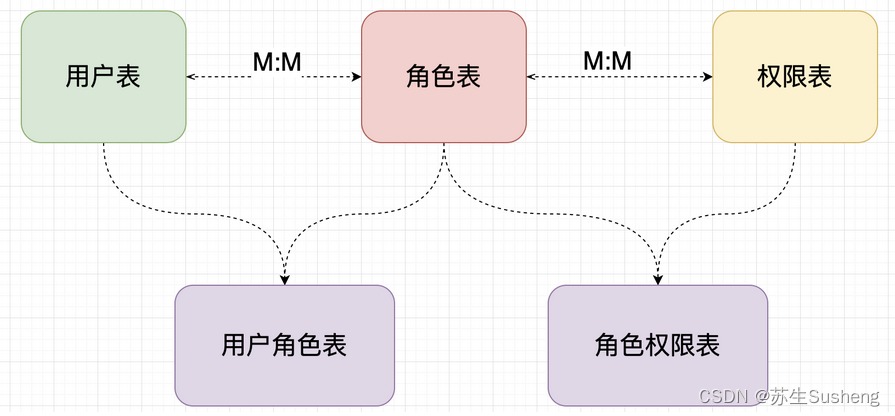
1.建表(五个核心表)
/*
Navicat Premium Data Transfer
Date: 11/04/2024 15:57:40
*/
SET NAMES utf8mb4;
SET FOREIGN_KEY_CHECKS = 0;
-- ----------------------------
-- Table structure for pers
-- ----------------------------
DROP TABLE IF EXISTS `pers`;
CREATE TABLE `pers` (
`id` int(6) NOT NULL AUTO_INCREMENT,
`name` varchar(80) CHARACTER SET utf8 COLLATE utf8_general_ci NULL DEFAULT NULL,
`url` varchar(255) CHARACTER SET utf8 COLLATE utf8_general_ci NULL DEFAULT NULL,
PRIMARY KEY (`id`) USING BTREE
) ENGINE = InnoDB AUTO_INCREMENT = 1 CHARACTER SET = utf8 COLLATE = utf8_general_ci ROW_FORMAT = Dynamic;
-- ----------------------------
-- Table structure for role
-- ----------------------------
DROP TABLE IF EXISTS `role`;
CREATE TABLE `role` (
`id` int(6) NOT NULL AUTO_INCREMENT,
`name` varchar(60) CHARACTER SET utf8 COLLATE utf8_general_ci NULL DEFAULT NULL,
PRIMARY KEY (`id`) USING BTREE
) ENGINE = InnoDB AUTO_INCREMENT = 1 CHARACTER SET = utf8 COLLATE = utf8_general_ci ROW_FORMAT = Dynamic;
-- ----------------------------
-- Table structure for role_perms
-- ----------------------------
DROP TABLE IF EXISTS `role_perms`;
CREATE TABLE `role_perms` (
`id` int(6) NOT NULL,
`roleid` int(6) NULL DEFAULT NULL,
`permsid` int(6) NULL DEFAULT NULL,
PRIMARY KEY (`id`) USING BTREE
) ENGINE = InnoDB CHARACTER SET = utf8 COLLATE = utf8_general_ci ROW_FORMAT = Dynamic;
-- ----------------------------
-- Table structure for t_user
-- ----------------------------
DROP TABLE IF EXISTS `user`;
CREATE TABLE `user` (
`id` int(6) NOT NULL AUTO_INCREMENT,
`username` varchar(40) CHARACTER SET utf8 COLLATE utf8_general_ci NULL DEFAULT NULL,
`password` varchar(40) CHARACTER SET utf8 COLLATE utf8_general_ci NULL DEFAULT NULL,
`salt` varchar(255) CHARACTER SET utf8 COLLATE utf8_general_ci NULL DEFAULT NULL,
PRIMARY KEY (`id`) USING BTREE
) ENGINE = InnoDB AUTO_INCREMENT = 2 CHARACTER SET = utf8 COLLATE = utf8_general_ci ROW_FORMAT = Dynamic;
-- ----------------------------
-- Table structure for user_role
-- ----------------------------
DROP TABLE IF EXISTS `user_role`;
CREATE TABLE `user_role` (
`id` int(6) NOT NULL,
`userid` int(6) NULL DEFAULT NULL,
`roleid` int(6) NULL DEFAULT NULL,
PRIMARY KEY (`id`) USING BTREE
) ENGINE = InnoDB CHARACTER SET = utf8 COLLATE = utf8_general_ci ROW_FORMAT = Dynamic;
SET FOREIGN_KEY_CHECKS = 1;
2.实体类、mapper、service、controller
实体类
package com.zjl.pojo;
import lombok.AllArgsConstructor;
import lombok.Data;
import lombok.NoArgsConstructor;
import lombok.ToString;
import lombok.experimental.Accessors;
import java.io.Serializable;
import java.util.List;
/**
* @author: zjl
* @datetime: 2024/4/11
* @desc:
*/
@Data
@Accessors(chain = true)
@NoArgsConstructor
@AllArgsConstructor
@ToString
public class User implements Serializable {
private String id;
private String username;
private String password;
private String salt;
//定义角色集合
private List<Role> roles;
}
package com.zjl.pojo;
import lombok.*;
import lombok.experimental.Accessors;
import java.io.Serializable;
/**
* @author: zjl
* @datetime: 2024/4/11
* @desc:
*/
@Data
@Accessors(chain = true)
@AllArgsConstructor
@NoArgsConstructor
public class Perms implements Serializable {
private String id;
private String name;
private String url;
}
package com.zjl.pojo;
import lombok.*;
import lombok.experimental.Accessors;
import java.io.Serializable;
import java.util.List;
/**
* @author: zjl
* @datetime: 2024/4/11
* @desc:
*/
@Data
@Accessors(chain = true)
@AllArgsConstructor
@NoArgsConstructor
public class Role implements Serializable {
private String id;
private String name;
//定义权限的集合
private List<Perms> perms;
}
mapper
package com.zjl.mapper;
import com.zjl.pojo.Perms;
import com.zjl.pojo.Role;
import com.zjl.pojo.User;
import org.apache.ibatis.annotations.Select;
import java.util.List;
/**
* @author: zjl
* @datetime: 2024/4/11
* @desc:
*/
public interface UserMapper {
void insert(User user);
@Select("select id,username,password,salt from user where username = #{username}")
User selectByUserName(String username);
//根据用户名查询所有角色
User selectRolesByUserName(String username);
//根据角色id查询权限集合
Role selectPermByRoleId(String id);
//根据角色id查询权限集合
List<Perms> selectPermsByRoleId(String id);
}
<?xml version="1.0" encoding="UTF-8" ?>
<!DOCTYPE mapper
PUBLIC "-//mybatis.org//DTD Config 3.0//EN"
"http://mybatis.org/dtd/mybatis-3-mapper.dtd">
<mapper namespace="com.zjl.mapper.UserMapper">
<insert id="insert" parameterType="com.zjl.pojo.User" useGeneratedKeys="true" keyProperty="id">
insert into user values(#{id},#{username},#{password},#{salt})
</insert>
<resultMap id="userMap" type="com.zjl.pojo.User">
<id column="uid" property="id"/>
<result column="username" property="username"/>
<!--角色信息-->
<collection property="roles" javaType="list" ofType="com.zjl.pojo.Role">
<id column="id" property="id"/>
<result column="rname" property="name"/>
</collection>
</resultMap>
<select id="selectRolesByUserName" parameterType="String" resultMap="userMap">
SELECT u.id uid,u.username,r.id,r.NAME rname
FROM user u
LEFT JOIN user_role ur
ON u.id=ur.userid
LEFT JOIN role r
ON ur.roleid=r.id
WHERE u.username=#{username}
</select>
<resultMap id="roleMap" type="com.zjl.pojo.Role">
<result column="name" property="name"/>
<collection property="perms" javaType="list" ofType="com.zjl.pojo.Perms">
<id column="id" property="id"/>
<result column="name" property="name"/>
<result column="url" property="url"/>
</collection>
</resultMap>
<select id="selectPermByRoleId" parameterType="String" resultMap="roleMap">
SELECT r.`name`,p.`id`,p.`name`,p.`url`
FROM role r
LEFT JOIN role_perms rp
ON r.`id` = rp.`roleid`
LEFT JOIN pers p
ON rp.`permsid` = p.`id`
WHERE r.`id` = #{id}
</select>
<select id="selectPermsByRoleId" parameterType="String" resultType="com.zjl.pojo.Perms">
SELECT p.id,p.NAME,p.url,r.NAME
FROM role r
LEFT JOIN role_perms rp
ON r.id=rp.roleid
LEFT JOIN pers p ON rp.permsid=p.id
WHERE r.id=#{id}
</select>
</mapper>
service
package com.zjl.service;
import com.zjl.mapper.UserMapper;
import com.zjl.pojo.Perms;
import com.zjl.pojo.Role;
import com.zjl.pojo.User;
import com.zjl.utils.SaltUtil;
import org.apache.shiro.crypto.hash.Md5Hash;
import org.springframework.stereotype.Service;
import org.springframework.transaction.annotation.Transactional;
import javax.annotation.Resource;
import java.util.List;
/**
* @author: zjl
* @datetime: 2024/4/11
* @desc:
*/
@Service
public class UserService {
@Resource
private UserMapper userMapper;
public void register(User user) {
//1.获取随机盐
String salt = SaltUtil.getSalt(8);
//2.将随机盐保存到数据
user.setSalt(salt);
//3.明文密码进行md5 + salt + hash散列
Md5Hash MD5 = new Md5Hash(user.getPassword(),salt,1024);
user.setPassword(MD5.toHex());
userMapper.insert(user);
}
public User getUserByUsername(String username) {
return userMapper.selectByUserName(username);
}
public User getRoleByUsername(String username) {
return userMapper.selectRolesByUserName(username);
}
public Role findPermByRoleId(String id) {
return userMapper.selectPermByRoleId(id);
}
public List<Perms> findPermsByRoleId2(String id) {
return userMapper.selectPermsByRoleId(id);
}
}
3.CustomerRealm
package com.zjl.realm;
import com.zjl.pojo.Perms;
import com.zjl.pojo.User;
import com.zjl.service.UserService;
import com.zjl.utils.ApplicationContextUtil;
import org.apache.shiro.authc.AuthenticationException;
import org.apache.shiro.authc.AuthenticationInfo;
import org.apache.shiro.authc.AuthenticationToken;
import org.apache.shiro.authc.SimpleAuthenticationInfo;
import org.apache.shiro.authz.AuthorizationInfo;
import org.apache.shiro.authz.SimpleAuthorizationInfo;
import org.apache.shiro.realm.AuthorizingRealm;
import org.apache.shiro.subject.PrincipalCollection;
import org.apache.shiro.util.ByteSource;
import org.springframework.util.CollectionUtils;
import org.springframework.util.ObjectUtils;
import java.util.List;
/**
* @author: zjl
* @datetime: 2024/4/11
* @desc:
*/
public class CustomerRealm extends AuthorizingRealm {
@Override
protected AuthorizationInfo doGetAuthorizationInfo(PrincipalCollection principalCollection) {
String principal = (String) principalCollection.getPrimaryPrincipal();
//获取UserService对象
UserService userService = ApplicationContextUtil.getBean(UserService.class);
//基于角色授权
User user = userService.getRoleByUsername(principal);
System.out.println("user======="+user);
if (!CollectionUtils.isEmpty(user.getRoles())) {
SimpleAuthorizationInfo info = new SimpleAuthorizationInfo();
user.getRoles().forEach(role ->{
info.addRole(role.getName());
/*Role role2 = userService.findPermByRoleId(role.getId());
System.out.println("role2======"+role2);
if (!CollectionUtils.isEmpty(role2.getPerms())) {
role2.getPerms().forEach(perm -> info.addStringPermission(perm.getName()));
}*/
//权限信息
List<Perms> perms = userService.getPermsByRoleId(role.getId());
System.out.println("perms========"+perms);
if(!CollectionUtils.isEmpty(perms) && perms.get(0)!=null ){
perms.forEach(perm->{
info.addStringPermission(perm.getName());
});
}
});
return info;
}
return null;
}
@Override
protected AuthenticationInfo doGetAuthenticationInfo(AuthenticationToken authenticationToken) throws AuthenticationException {
String principal = (String) authenticationToken.getPrincipal();
UserService userService = ApplicationContextUtil.getBean(UserService.class);
User user = userService.getUserByUsername(principal);
if (!ObjectUtils.isEmpty(user)) {
return new SimpleAuthenticationInfo(user.getUsername(), user.getPassword(), ByteSource.Util.bytes(user.getSalt()), this.getName());
}
return null;
}
}
4.页面(index.jsp)
<%@page contentType="text/html;UTF-8" pageEncoding="UTF-8" isErrorPage="false" %>
<%@taglib prefix="shiro" uri="http://shiro.apache.org/tags" %>
<!doctype html>
<html lang="en">
<head>
<meta charset="UTF-8">
<meta name="viewport"
content="width=device-width, user-scalable=no, initial-scale=1.0, maximum-scale=1.0, minimum-scale=1.0">
<meta http-equiv="X-UA-Compatible" content="ie=edge">
<title>首页</title>
</head>
<body>
<%--受限资源--%>
<h1>系统主页</h1>
<a href="${pageContext.request.contextPath}/user/logout">退出登录</a>
<ul>
<shiro:hasRole name="user">
<li><a href="#">用户管理</a></li>
<ul>
<shiro:hasPermission name="user:save:*">
<li><a href="#">增加</a></li>
</shiro:hasPermission>
<shiro:hasPermission name="user:delete:*">
<li><a href="#">删除</a></li>
</shiro:hasPermission>
<shiro:hasPermission name="user:update:*">
<li><a href="#">修改</a></li>
</shiro:hasPermission>
<shiro:hasPermission name="user:find:*">
<li><a href="#">查询</a></li>
</shiro:hasPermission>
</ul>
</shiro:hasRole>
<shiro:hasRole name="admin">
<li><a href="#">商品管理</a></li>
<li><a href="#">订单管理</a></li>
<li><a href="#">物流管理</a></li>
</shiro:hasRole>
</ul>
</body>
</html>
5.数据参考

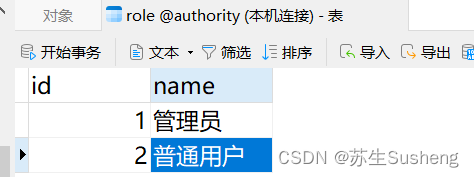
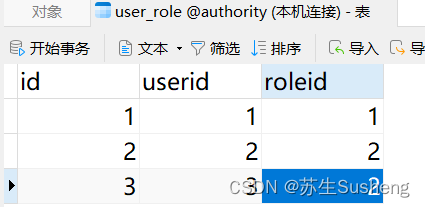

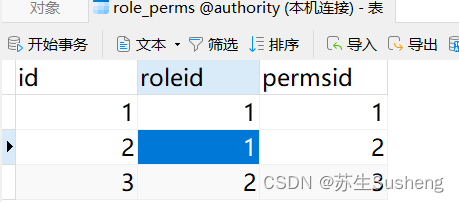
6.测试
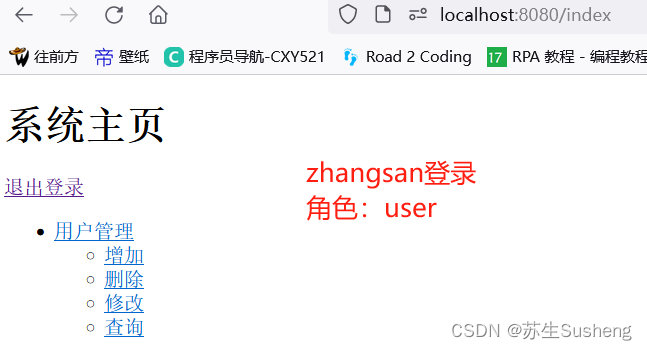
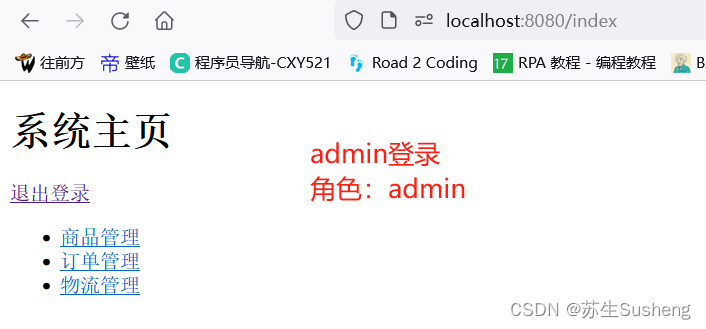
Shiro结合缓存
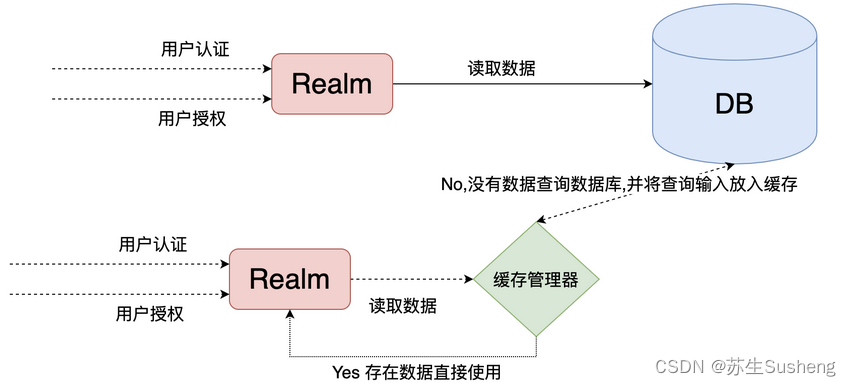
整合redis
1.依赖
<!--引入shiro和ehcache-->
<!-- <dependency>
<groupId>org.apache.shiro</groupId>
<artifactId>shiro-ehcache</artifactId>
<version>1.5.3</version>
</dependency> -->
<!--redis整合springboot-->
<dependency>
<groupId>org.springframework.boot</groupId>
<artifactId>spring-boot-starter-data-redis</artifactId>
</dependency>
2.配置
spring:
redis:
host: localhost
port: 6379
password: 123456
database: 0
3.Redis相关类
package com.zjl.redis;
import com.zjl.utils.ApplicationContextUtil;
import org.apache.shiro.cache.Cache;
import org.apache.shiro.cache.CacheException;
import org.springframework.data.redis.core.RedisTemplate;
import org.springframework.data.redis.serializer.StringRedisSerializer;
import java.util.Collection;
import java.util.Set;
/**
* @author: zjl
* @datetime: 2024/4/12
* @desc:自定义redis缓存的实现
*/
public class RedisCache<k,v> implements Cache<k,v> {
private String cacheName;
public RedisCache() {
}
public RedisCache(String cacheName) {
this.cacheName = cacheName;
}
@Override
public v get(k k) throws CacheException {
return (v) getRedisTemplate().opsForHash().get(this.cacheName, k.toString());
}
@Override
public v put(k k, v v) throws CacheException {
System.out.println("put key: "+k);
System.out.println("put value:"+v);
getRedisTemplate().opsForHash().put(this.cacheName,k.toString(), v);
return null;
}
@Override
public v remove(k k) throws CacheException {
System.out.println("=============remove=============");
return (v) getRedisTemplate().opsForHash().delete(this.cacheName,k.toString());
}
@Override
public void clear() throws CacheException {
System.out.println("=============clear==============");
getRedisTemplate().delete(this.cacheName);
}
@Override
public int size() {
return getRedisTemplate().opsForHash().size(this.cacheName).intValue();
}
@Override
public Set<k> keys() {
return getRedisTemplate().opsForHash().keys(this.cacheName);
}
@Override
public Collection<v> values() {
return getRedisTemplate().opsForHash().values(this.cacheName);
}
private RedisTemplate getRedisTemplate(){
RedisTemplate redisTemplate = ApplicationContextUtil.getBean("redisTemplate",RedisTemplate.class);
redisTemplate.setKeySerializer(new StringRedisSerializer());
redisTemplate.setHashKeySerializer(new StringRedisSerializer());
return redisTemplate;
}
}
package com.zjl.redis;
import org.apache.shiro.cache.Cache;
import org.apache.shiro.cache.CacheException;
import org.apache.shiro.cache.CacheManager;
/**
* @author: zjl
* @datetime: 2024/4/12
* @desc:
*/
public class RedisCacheManager implements CacheManager {
//参数1:认证或者是授权缓存的统一名称
@Override
public <K, V> Cache<K, V> getCache(String cacheName) throws CacheException {
System.out.println(cacheName);
return new RedisCache<K,V>(cacheName);
}
}
4.自定义salt实现 实现序列化接口
package com.zjl.utils;
import org.apache.shiro.codec.Base64;
import org.apache.shiro.codec.CodecSupport;
import org.apache.shiro.codec.Hex;
import org.apache.shiro.util.ByteSource;
import java.io.File;
import java.io.InputStream;
import java.io.Serializable;
import java.util.Arrays;
/**
* @author: zjl
* @datetime: 2024/4/12
* @desc:自定义salt实现 实现序列化接口
*/
public class MyByteSource implements ByteSource, Serializable {
private byte[] bytes;
private String cachedHex;
private String cachedBase64;
public MyByteSource(byte[] bytes) {
this.bytes = bytes;
}
public MyByteSource(char[] chars) {
this.bytes = CodecSupport.toBytes(chars);
}
public MyByteSource(String string) {
this.bytes = CodecSupport.toBytes(string);
}
public MyByteSource(ByteSource source) {
this.bytes = source.getBytes();
}
public MyByteSource(File file) {
this.bytes = (new MyByteSource.BytesHelper()).getBytes(file);
}
public MyByteSource(InputStream stream) {
this.bytes = (new MyByteSource.BytesHelper()).getBytes(stream);
}
public static boolean isCompatible(Object o) {
return o instanceof byte[] || o instanceof char[] || o instanceof String || o instanceof ByteSource || o instanceof File || o instanceof InputStream;
}
@Override
public byte[] getBytes() {
return this.bytes;
}
@Override
public boolean isEmpty() {
return this.bytes == null || this.bytes.length == 0;
}
@Override
public String toHex() {
if (this.cachedHex == null) {
this.cachedHex = Hex.encodeToString(this.getBytes());
}
return this.cachedHex;
}
@Override
public String toBase64() {
if (this.cachedBase64 == null) {
this.cachedBase64 = Base64.encodeToString(this.getBytes());
}
return this.cachedBase64;
}
@Override
public String toString() {
return this.toBase64();
}
@Override
public int hashCode() {
return this.bytes != null && this.bytes.length != 0 ? Arrays.hashCode(this.bytes) : 0;
}
@Override
public boolean equals(Object o) {
if (o == this) {
return true;
} else if (o instanceof ByteSource) {
ByteSource bs = (ByteSource) o;
return Arrays.equals(this.getBytes(), bs.getBytes());
} else {
return false;
}
}
private static final class BytesHelper extends CodecSupport {
private BytesHelper() {
}
public byte[] getBytes(File file) {
return this.toBytes(file);
}
public byte[] getBytes(InputStream stream) {
return this.toBytes(stream);
}
}
}
5.修改自定义realm中使用的salt
package com.zjl.realm;
import com.zjl.pojo.Perms;
import com.zjl.pojo.User;
import com.zjl.service.UserService;
import com.zjl.utils.ApplicationContextUtil;
import com.zjl.utils.MyByteSource;
import org.apache.shiro.authc.AuthenticationException;
import org.apache.shiro.authc.AuthenticationInfo;
import org.apache.shiro.authc.AuthenticationToken;
import org.apache.shiro.authc.SimpleAuthenticationInfo;
import org.apache.shiro.authz.AuthorizationInfo;
import org.apache.shiro.authz.SimpleAuthorizationInfo;
import org.apache.shiro.realm.AuthorizingRealm;
import org.apache.shiro.subject.PrincipalCollection;
import org.apache.shiro.util.ByteSource;
import org.springframework.util.CollectionUtils;
import org.springframework.util.ObjectUtils;
import java.util.List;
/**
* @author: zjl
* @datetime: 2024/4/11
* @desc:
*/
public class CustomerRealm extends AuthorizingRealm {
@Override
protected AuthorizationInfo doGetAuthorizationInfo(PrincipalCollection principalCollection) {
String principal = (String) principalCollection.getPrimaryPrincipal();
//获取UserService对象
UserService userService = ApplicationContextUtil.getBean(UserService.class);
//基于角色授权
User user = userService.getRoleByUsername(principal);
System.out.println("user======="+user);
if (!CollectionUtils.isEmpty(user.getRoles())) {
SimpleAuthorizationInfo info = new SimpleAuthorizationInfo();
user.getRoles().forEach(role ->{
info.addRole(role.getName());
/*Role role2 = userService.findPermByRoleId(role.getId());
System.out.println("role2======"+role2);
if (!CollectionUtils.isEmpty(role2.getPerms())) {
role2.getPerms().forEach(perm -> info.addStringPermission(perm.getName()));
}*/
//权限信息
List<Perms> perms = userService.getPermsByRoleId(role.getId());
System.out.println("perms========"+perms);
if(!CollectionUtils.isEmpty(perms) && perms.get(0)!=null ){
perms.forEach(perm->{
info.addStringPermission(perm.getName());
});
}
});
return info;
}
return null;
}
@Override
protected AuthenticationInfo doGetAuthenticationInfo(AuthenticationToken authenticationToken) throws AuthenticationException {
String principal = (String) authenticationToken.getPrincipal();
//获取UserService对象
UserService userService = ApplicationContextUtil.getBean(UserService.class);
User user = userService.getUserByUsername(principal);
if (!ObjectUtils.isEmpty(user)) {
return new SimpleAuthenticationInfo(user.getUsername(), user.getPassword(), new MyByteSource(user.getSalt()), this.getName());
}
return null;
}
}
6.ShiroConfig创建自定义realm
//3.创建自定义realm
@Bean
public Realm getRealm() {
CustomerRealm realm = new CustomerRealm();
HashedCredentialsMatcher credentialsMatcher = new HashedCredentialsMatcher();
//设置使用MD5加密算法
credentialsMatcher.setHashAlgorithmName("md5");
//散列次数
credentialsMatcher.setHashIterations(1024);
realm.setCredentialsMatcher(credentialsMatcher);
//开启缓存管理器
realm.setCacheManager(new RedisCacheManager());
realm.setCachingEnabled(true);//开启缓存
realm.setAuthenticationCachingEnabled(true);//开启认证缓存
realm.setAuthenticationCacheName("authentication");
realm.setAuthorizationCachingEnabled(true);//开启授权缓存
realm.setAuthorizationCacheName("authorization");
return realm;
}
7.测试


shrio实现验证功能
1.验证码工具类
package com.zjl.utils;
import javax.imageio.ImageIO;
import java.awt.*;
import java.awt.geom.AffineTransform;
import java.awt.image.BufferedImage;
import java.io.File;
import java.io.FileOutputStream;
import java.io.IOException;
import java.io.OutputStream;
import java.util.Arrays;
import java.util.Random;
/**
* @author: zjl
* @datetime: 2024/4/12
* @desc:
*/
public class VerifyCodeUtils{
//使用到Algerian字体,系统里没有的话需要安装字体,字体只显示大写,去掉了1,0,i,o几个容易混淆的字符
public static final String VERIFY_CODES = "23456789ABCDEFGHJKLMNPQRSTUVWXYZ";
private static Random random = new Random();
/**
* 使用系统默认字符源生成验证码
* @param verifySize 验证码长度
* @return
*/
public static String generateVerifyCode(int verifySize){
return generateVerifyCode(verifySize, VERIFY_CODES);
}
/**
* 使用指定源生成验证码
* @param verifySize 验证码长度
* @param sources 验证码字符源
* @return
*/
public static String generateVerifyCode(int verifySize, String sources){
if(sources == null || sources.length() == 0){
sources = VERIFY_CODES;
}
int codesLen = sources.length();
Random rand = new Random(System.currentTimeMillis());
StringBuilder verifyCode = new StringBuilder(verifySize);
for(int i = 0; i < verifySize; i++){
verifyCode.append(sources.charAt(rand.nextInt(codesLen-1)));
}
return verifyCode.toString();
}
/**
* 生成随机验证码文件,并返回验证码值
* @param w
* @param h
* @param outputFile
* @param verifySize
* @return
* @throws IOException
*/
public static String outputVerifyImage(int w, int h, File outputFile, int verifySize) throws IOException{
String verifyCode = generateVerifyCode(verifySize);
outputImage(w, h, outputFile, verifyCode);
return verifyCode;
}
/**
* 输出随机验证码图片流,并返回验证码值
* @param w
* @param h
* @param os
* @param verifySize
* @return
* @throws IOException
*/
public static String outputVerifyImage(int w, int h, OutputStream os, int verifySize) throws IOException{
String verifyCode = generateVerifyCode(verifySize);
outputImage(w, h, os, verifyCode);
return verifyCode;
}
/**
* 生成指定验证码图像文件
* @param w
* @param h
* @param outputFile
* @param code
* @throws IOException
*/
public static void outputImage(int w, int h, File outputFile, String code) throws IOException{
if(outputFile == null){
return;
}
File dir = outputFile.getParentFile();
if(!dir.exists()){
dir.mkdirs();
}
try{
outputFile.createNewFile();
FileOutputStream fos = new FileOutputStream(outputFile);
outputImage(w, h, fos, code);
fos.close();
} catch(IOException e){
throw e;
}
}
/**
* 输出指定验证码图片流
* @param w
* @param h
* @param os
* @param code
* @throws IOException
*/
public static void outputImage(int w, int h, OutputStream os, String code) throws IOException{
int verifySize = code.length();
BufferedImage image = new BufferedImage(w, h, BufferedImage.TYPE_INT_RGB);
Random rand = new Random();
Graphics2D g2 = image.createGraphics();
g2.setRenderingHint(RenderingHints.KEY_ANTIALIASING,RenderingHints.VALUE_ANTIALIAS_ON);
Color[] colors = new Color[5];
Color[] colorSpaces = new Color[] { Color.WHITE, Color.CYAN,
Color.GRAY, Color.LIGHT_GRAY, Color.MAGENTA, Color.ORANGE,
Color.PINK, Color.YELLOW };
float[] fractions = new float[colors.length];
for(int i = 0; i < colors.length; i++){
colors[i] = colorSpaces[rand.nextInt(colorSpaces.length)];
fractions[i] = rand.nextFloat();
}
Arrays.sort(fractions);
g2.setColor(Color.GRAY);// 设置边框色
g2.fillRect(0, 0, w, h);
Color c = getRandColor(200, 250);
g2.setColor(c);// 设置背景色
g2.fillRect(0, 2, w, h-4);
//绘制干扰线
Random random = new Random();
g2.setColor(getRandColor(160, 200));// 设置线条的颜色
for (int i = 0; i < 20; i++) {
int x = random.nextInt(w - 1);
int y = random.nextInt(h - 1);
int xl = random.nextInt(6) + 1;
int yl = random.nextInt(12) + 1;
g2.drawLine(x, y, x + xl + 40, y + yl + 20);
}
// 添加噪点
float yawpRate = 0.05f;// 噪声率
int area = (int) (yawpRate * w * h);
for (int i = 0; i < area; i++) {
int x = random.nextInt(w);
int y = random.nextInt(h);
int rgb = getRandomIntColor();
image.setRGB(x, y, rgb);
}
shear(g2, w, h, c);// 使图片扭曲
g2.setColor(getRandColor(100, 160));
int fontSize = h-4;
Font font = new Font("Algerian", Font.ITALIC, fontSize);
g2.setFont(font);
char[] chars = code.toCharArray();
for(int i = 0; i < verifySize; i++){
AffineTransform affine = new AffineTransform();
affine.setToRotation(Math.PI / 4 * rand.nextDouble() * (rand.nextBoolean() ? 1 : -1), (w / verifySize) * i + fontSize/2, h/2);
g2.setTransform(affine);
g2.drawChars(chars, i, 1, ((w-10) / verifySize) * i + 5, h/2 + fontSize/2 - 10);
}
g2.dispose();
ImageIO.write(image, "jpg", os);
}
private static Color getRandColor(int fc, int bc) {
if (fc > 255)
fc = 255;
if (bc > 255)
bc = 255;
int r = fc + random.nextInt(bc - fc);
int g = fc + random.nextInt(bc - fc);
int b = fc + random.nextInt(bc - fc);
return new Color(r, g, b);
}
private static int getRandomIntColor() {
int[] rgb = getRandomRgb();
int color = 0;
for (int c : rgb) {
color = color << 8;
color = color | c;
}
return color;
}
private static int[] getRandomRgb() {
int[] rgb = new int[3];
for (int i = 0; i < 3; i++) {
rgb[i] = random.nextInt(255);
}
return rgb;
}
private static void shear(Graphics g, int w1, int h1, Color color) {
shearX(g, w1, h1, color);
shearY(g, w1, h1, color);
}
private static void shearX(Graphics g, int w1, int h1, Color color) {
int period = random.nextInt(2);
boolean borderGap = true;
int frames = 1;
int phase = random.nextInt(2);
for (int i = 0; i < h1; i++) {
double d = (double) (period >> 1)
* Math.sin((double) i / (double) period
+ (6.2831853071795862D * (double) phase)
/ (double) frames);
g.copyArea(0, i, w1, 1, (int) d, 0);
if (borderGap) {
g.setColor(color);
g.drawLine((int) d, i, 0, i);
g.drawLine((int) d + w1, i, w1, i);
}
}
}
private static void shearY(Graphics g, int w1, int h1, Color color) {
int period = random.nextInt(40) + 10; // 50;
boolean borderGap = true;
int frames = 20;
int phase = 7;
for (int i = 0; i < w1; i++) {
double d = (double) (period >> 1)
* Math.sin((double) i / (double) period
+ (6.2831853071795862D * (double) phase)
/ (double) frames);
g.copyArea(i, 0, 1, h1, 0, (int) d);
if (borderGap) {
g.setColor(color);
g.drawLine(i, (int) d, i, 0);
g.drawLine(i, (int) d + h1, i, h1);
}
}
}
public static void main(String[] args) throws IOException {
//获取验证码
String s = generateVerifyCode(4);
//将验证码放入图片中
outputImage(260,60,new File("/Users/chenyannan/Desktop/安工资料/aa.jpg"),s);
System.out.println(s);
}
}
2.登录页面
<%@page contentType="text/html;UTF-8" pageEncoding="UTF-8" isErrorPage="false" %>
<!doctype html>
<html lang="en">
<head>
<meta charset="UTF-8">
<meta name="viewport"
content="width=device-width, user-scalable=no, initial-scale=1.0, maximum-scale=1.0, minimum-scale=1.0">
<meta http-equiv="X-UA-Compatible" content="ie=edge">
<title>登录</title>
</head>
<body>
<h1>登录界面</h1>
<form action="${pageContext.request.contextPath}/login" method="post">
用户名:<input type="text" name="username"> <br/>
密码 : <input type="text" name="password"> <br/>
请输入验证码: <input type="text" name="code"><img src="${pageContext.request.contextPath}/getImage" alt=""><br/>
<input type="submit" value="登录">
</form>
</body>
</html>
3.Controller
@RequestMapping("getImage")
public void getImage(HttpSession session, HttpServletResponse response) throws IOException {
//生成验证码
String code = VerifyCodeUtils.generateVerifyCode(4);
//验证码放入session
session.setAttribute("code",code);
//验证码存入图片
ServletOutputStream os = response.getOutputStream();
response.setContentType("image/png");
VerifyCodeUtils.outputImage(220,60,os,code);
}
//修改认证流程
@RequestMapping("login")
public String login(String username, String password,String code,HttpSession session) {
//比较验证码
String codes = (String) session.getAttribute("code");
try {
if (codes.equalsIgnoreCase(code)){
//获取主体对象
Subject subject = SecurityUtils.getSubject();
subject.login(new UsernamePasswordToken(username, password));
return "redirect:/index";
}else{
throw new RuntimeException("验证码错误!");
}
} catch (UnknownAccountException e) {
e.printStackTrace();
System.out.println("用户名错误!");
} catch (IncorrectCredentialsException e) {
e.printStackTrace();
System.out.println("密码错误!");
}catch (Exception e){
e.printStackTrace();
System.out.println(e.getMessage());
}
return "redirect:/";
}
4.验证码放行
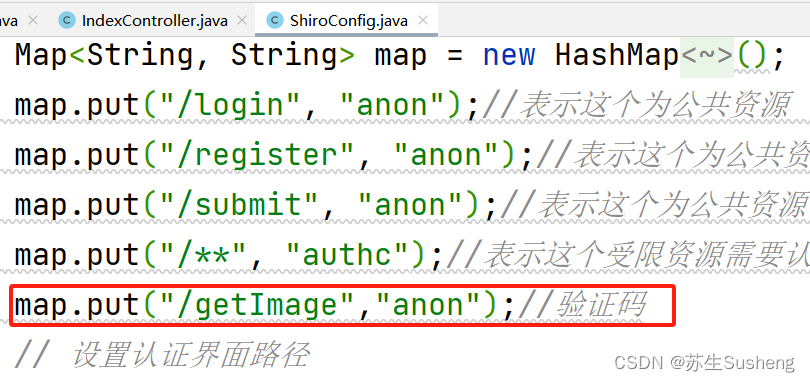
map.put("/getImage","anon");//验证码
5.测试
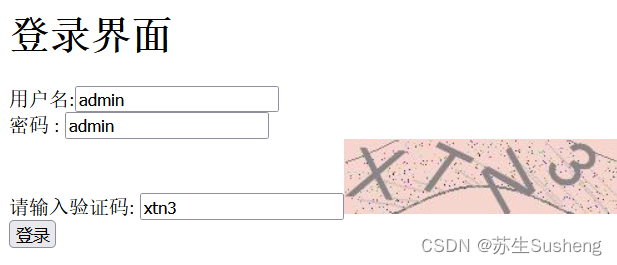
JSP中的Shiro标签解释
<!-- 需要在jsp页面中引入标签 -->
<%@ taglib uri="http://shiro.apache.org/tags" prefix="shiro" %>
标签:
<shiro:authenticated> 登录之后
<shiro:notAuthenticated> 不在登录状态时
<shiro:guest> 用户在没有RememberMe时
<shiro:user> 用户在RememberMe时
<shiro:hasAnyRoles name="abc,123" > 在有abc或者123角色时
<shiro:hasRole name="abc"> 拥有角色abc
<shiro:lacksRole name="abc"> 没有角色abc
<shiro:hasPermission name="abc"> 拥有权限资源abc <shiro:lacksPermission name="abc"> 没有abc权限资源
<shiro:principal> 显示用户身份名称
<shiro:principal property="username"/> 显示用户身份中的属性值
Shiro与thymeleaf
1.依赖
<dependency>
<groupId>com.github.theborakompanioni</groupId>
<artifactId>thymeleaf-extras-shiro</artifactId>
<version>2.0.0</version>
</dependency>
2.常见权限控制标签使用
<!-- 验证当前用户是否为“访客”,即未认证(包含未记住)的用户。 -->
<p shiro:guest="">Please <a href="login.html">login</a></p>
<!-- 认证通过或已记住的用户。 -->
<p shiro:user="">
Welcome back John! Not John? Click <a href="login.html">here</a> to login.
</p>
<!-- 已认证通过的用户。不包含已记住的用户,这是与user标签的区别所在。 -->
<p shiro:authenticated="">
Hello, <span shiro:principal=""></span>, how are you today?
</p>
<a shiro:authenticated="" href="updateAccount.html">Update your contact information</a>
<!-- 输出当前用户信息,通常为登录帐号信息。 -->
<p>Hello, <shiro:principal/>, how are you today?</p>
<!-- 未认证通过用户,与authenticated标签相对应。与guest标签的区别是,该标签包含已记住用户。 -->
<p shiro:notAuthenticated="">
Please <a href="login.html">login</a> in order to update your credit card information.
</p>
<!-- 验证当前用户是否属于该角色。 -->
<a shiro:hasRole="admin" href="admin.html">Administer the system</a><!-- 拥有该角色 -->
<!-- 与hasRole标签逻辑相反,当用户不属于该角色时验证通过。 -->
<p shiro:lacksRole="developer"><!-- 没有该角色 -->
Sorry, you are not allowed to developer the system.
</p>
<!-- 验证当前用户是否属于以下所有角色。 -->
<p shiro:hasAllRoles="developer, 2"><!-- 角色与判断 -->
You are a developer and a admin.
</p>
<!-- 验证当前用户是否属于以下任意一个角色。 -->
<p shiro:hasAnyRoles="admin, vip, developer,1"><!-- 角色或判断 -->
You are a admin, vip, or developer.
</p>
<!--验证当前用户是否拥有指定权限。 -->
<a shiro:hasPermission="userInfo:add" href="createUser.html">添加用户</a><!-- 拥有权限 -->
<!-- 与hasPermission标签逻辑相反,当前用户没有制定权限时,验证通过。 -->
<p shiro:lacksPermission="userInfo:del"><!-- 没有权限 -->
Sorry, you are not allowed to delete user accounts.
</p>
<!-- 验证当前用户是否拥有以下所有角色。 -->
<p shiro:hasAllPermissions="userInfo:view, userInfo:add"><!-- 权限与判断 -->
You can see or add users.
</p>
<!-- 验证当前用户是否拥有以下任意一个权限。 -->
<p shiro:hasAnyPermissions="userInfo:view, userInfo:del"><!-- 权限或判断 -->
You can see or delete users.
</p>
<a shiro:hasPermission="pp" href="createUser.html">Create a new User</a>
3.加入shiro的方言配置
若页面标签不起作用一定要记住加入方言处理
@Bean(name = “shiroDialect”)
public ShiroDialect shiroDialect(){
return new ShiroDialect();
}
